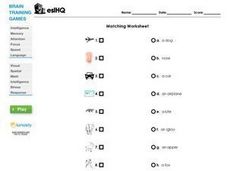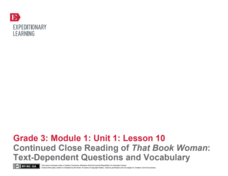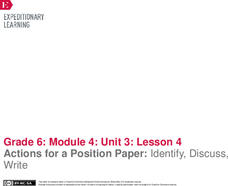Curated OER
Good vs. Evil
Make a study of good and evil by examining a short legend. After reading, learners compose their own stories and participate in a class discussion about the text, the characters, and the message of the reading.
Curated OER
ESL: Beginning Vocabulary Matching
Beginning English Learners match 10 line-drawn pictures of basic nouns with their names, such as kite, airplane, goat, and igloo. Indefinite articles are included, so this exercise also provides reinforcement for the a/an rule.
Curated OER
ESL: Classmates Survey
Get your beginning English Learners moving with this class survey. They ask each other the 8 questions provided to find out "How many of your classmates..." Good practice for asking questions that start with"Do you..." including "make...
Curated OER
Writer's Toolbox
Present the class with a slide show that will give them a great head start in writing expository and narrative texts. The information is highlighted for easy note taking, well organized, and presented in a kid-friendly manner. It...
Scholastic
A Reading Guide to A Wrinkle in Time
Accompany a reading of Madeleine L'Engle's classic tale, A Wrinkle in Time, with a detailed guide equipped with 15 informative and useful chapters. Scholars discover who the author is, why she wrote the book, and crucial story elements...
EngageNY
Continued Close Reading of Rain School: Text-Dependent Questions and Vocabulary
The engaging story Rain School is further explored in the third lesson of a larger unit that explicitly teaches close reading skills by answering questions whose answers can only be found inside the text. Through teacher...
EngageNY
Continued Close Reading of That Book Woman: Text-Dependent Questions and Vocabulary
Explicitly explained and delightfully detailed are two ways to describe this tenth lesson plan in a larger unit designed for the first few weeks of third grade. Learners continue to use and develop previously learned close reading...
Odell Education
Reading Closely for Textual Details: Grade 12
Help your class examine humanity's unpredictable nature through "Life Steps Almost Straight." Learners read various works from philosophers such as Viktor Frankl, The Buddha, and Nietzsche to gather textual evidence and explain their...
Curated OER
Building Bridges for Young Learners--Culture
Students explore the concept of "culture." In this cross curriculum literacy and world history lesson, students listen to a letter written by a child from Namibia, then compare and contrast life in Africa with their own life. Students...
Curated OER
Sentence Completion 8 (low-advanced SAT level))
Proficient English language learners or native English speakers develop vocabulary with this five-page packet. The first page contains six fill-in-the-blank questions, and learners must decide which word or words best completes the...
Curated OER
Reading Comprehension - Informational Passages " Leonardo da Vinci'
Practice reading comprehension and teach your English acquisition class about Leonardo da Vinci. This learning exercise provides a short informational text entitled, "Leonardo da Vinci." Learners answer five multiple choice comprehension...
Curated OER
Left to Right Kittens
Oh no! The kittens have lost their mittens! Help young learners develop fine-motor skills by drawing straight lines from three kittens to their pair of mittens. Use this to show young learners that things move left to right, just like...
Curated OER
High-Frequency Phrases: Third 100 Words
Choral response is a great way to assist English learners with proper pronunciation. Use this resource to help your ELD class see, say, and understand high-frequency phrases. Each slide contains one phrase, there is no audio or animation...
Curated OER
Countering Anxiety
Strengthen life skills with practice reframing anxious thoughts. First, learners develop rational counter-statements to provided anxiety-producing thoughts. Then they extend the skill to identify and reframe anxiety-producing thoughts of...
Media Smarts
Marketing to Teens: Alternate Ads
Did you know that Coke can teach the world to sing in perfect harmony? Learners develop an awareness of more subtle, less obvious methods advertisers use to reach consumers. Included is a list of related lessons available on the Media...
Missouri Department of Elementary
Conflict Mediation – Part 1: Getting Ready
Two scholars walk into a room arguing, what is happening? Peers observe the two actors in preparation for a whole-class discussion about conflict. Learners establish a conflict, name the three approaches—passive, aggressive, and...
American Institute of Architects
Architecture: It's Elementary!—Fifth Grade
Young citizens construct an understanding of urban planning in this cross-curricular unit. Covering every aspect of city development from the political, economic, and social influences to sustainable building practices, this...
EngageNY
Presentation of Events: Comparing Two Authors
Give a little clue! Readers learn how context clues can help them determine the meaning of words by viewing a Context Clues Resource sheet then completing a Context Clues
practice sheet. They then compare events presented by two...
Curated OER
Vocabulary/Reading Lesson for Students with Severe Intellectual Disabilities
Here is a great little reading and vocabulary development lesson created just for learners with special needs. The lesson is constructed with both core content and necessary adaptations in mind. The group will use PECS, pointing/gesture,...
EngageNY
Introducing “Comprehending the Calamity”
Some things are beyond comprehension. Scholars read an excerpt from "Comprehending the Calamity," a primary source text about the 1906 San Francisco earthquake. After identifying the gist, pupils complete anchor charts to analyze how the...
EngageNY
Actions for a Position Paper: Identify, Discuss, Write
Anchors aweigh, it's time to write! After viewing an anchor chart detailing the parts of a position paper, pupils share their plans for their essays with a partner. Next, they write the rough draft of their body paragraphs.
Virginia Department of Education
Identifying the Main Idea in Fiction
Discovering the main idea in fiction is like uncovering buried treasure; one must persevere to locate it, and the reward is priceless. Scholars delve deep into leveled stories using three questions to aid in identifying the main idea.
21 x 20 Media
A+ Writing Prompts
Shake it up! Shake your tablet to bring up a unique writing prompt for journaling or blogging with your class. Shake again and a new one appears. Prompts can come from different categories (sketches, scenes, texts, words, news) to help...
Road to Grammar
Fame
Smile for the camera and find out how your English language learners feel about fame! Class members read three different points of view on fame and then discuss ten questions about the topic.























